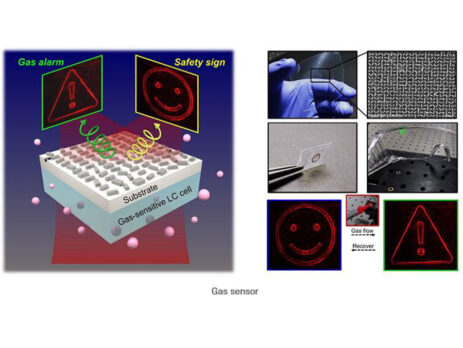Wearable hologram sensor that can detect toxic gases
Gas accidents such as toxic gas leakage in factories, carbon monoxide leakage of boilers, or toxic gas suffocation during manhole cleaning continue to claim lives and cause injuries. Developing a sensor that can quickly detect toxic gases or biochemicals is still an important issue in public health, environmental monitoring, and military sectors. Recently, a research team at POSTECH has developed an inexpensive, ultra-compact wearable hologram sensor that immediately notifies the user of volatile gas detection.
Using the metasurface, the research team developed a gas sensor that can float a holographic image alarm in space in just a few seconds by using the polarization control of transmitted light that transforms due to the change in orientation of liquid crystal molecules in the liquid crystal layer inside the sensor device when exposed to gas. Moreover, this gas sensor developed by the research team requires no support from external mechanical or electronic devices, unlike other conventional commercial gas sensors. The researchers used isopropyl alcohol as the target hazardous gas, known as a toxic substance that can cause stomach pain, headache, dizziness, and even leukemia.
In an actual experiment using a board marker, a volatile gas source in our daily life, a visual holographic alarm popped up instantaneously the moment the marker was brought to the sensor.
Moreover, the research team developed a one-step nanocomposite printing method to produce this flexible and wearable gas sensor. The metasurface structure, which was previously processed on a hard substrate, was designed to enable rapid production with a single-step nanocasting process on a curved or flexible substrate.
Going a step further, the research team is developing a high-performance environmental sensor that can display the type and concentration level of gases or biochemicals in the surroundings with a holographic alarm, and is studying optical design techniques that can encode various holographic images.
